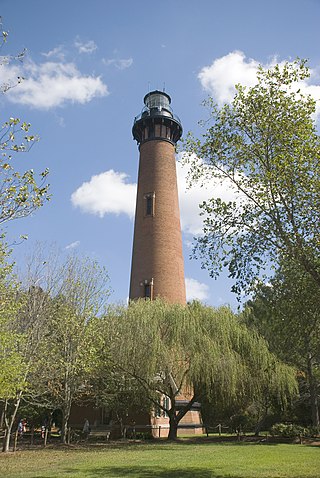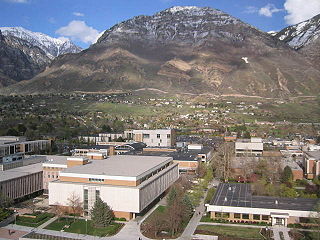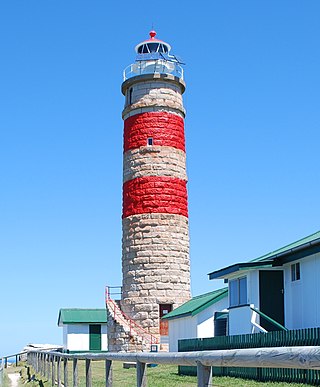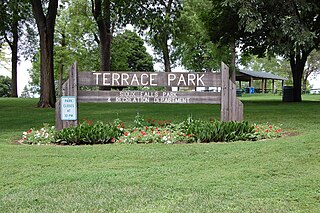
Jackson is the only city in, and seat of government of, Jackson County in the U.S. state of Michigan. As of the 2020 census, the city population was 31,309. Located along Interstate 94 and U.S. Route 127, it is approximately 40 miles (64 km) west of Ann Arbor and 35 miles (56 km) south of Lansing. Jackson is the core city of the Jackson Metropolitan Statistical Area, which includes all of Jackson County and has a population of 160,248.

Buckingham Fountain is a Chicago Landmark in the center of Grant Park, between Queen's Landing and the end of Ida B. Wells Drive. Dedicated in 1927 and donated to the city by philanthropist Kate S. Buckingham, it is one of the largest fountains in the world. Built in a rococo wedding cake style and inspired by the Latona Fountain at the Palace of Versailles, its design allegorically represents nearby Lake Michigan. The fountain operates generally from mid-April to mid-October, with regular water-jet displays and evening colored-light shows. During the winter, the fountain is decorated with festival lights.

Tower Bridge is a Grade I listed combined bascule, suspension, and, until 1960, cantilever bridge in London, built between 1886 and 1894, designed by Horace Jones and engineered by John Wolfe Barry with the help of Henry Marc Brunel. It crosses the River Thames close to the Tower of London and is one of five London bridges owned and maintained by the City Bridge Foundation, a charitable trust founded in 1282.

The Washington Monument is an obelisk on the National Mall in Washington, D.C., built to commemorate George Washington, a Founding Father of the United States, victorious commander-in-chief of the Continental Army from 1775 to 1783 in the American Revolutionary War, and the first President of the United States from 1789 to 1797. Standing east of the Reflecting Pool and the Lincoln Memorial, the monument is made of bluestone gneiss for the foundation and of granite for the construction. The outside facing consists, due to the interrupted building process, of three different kinds of white marble: in the lower third, marble from Baltimore County, Maryland, followed by a narrow zone of marble from Sheffield, Berkshire County, Massachusetts, and, in the upper part, the so-called Cockeysville Marble. Both "Maryland Marbles" came from the "lost” Irish Quarry Town of "New Texas". It is both the world's tallest predominantly stone structure and the world's tallest obelisk, standing 554 feet 7+11⁄32 inches (169.046 m) tall, according to U.S. National Geodetic Survey measurements in 2013–2014. It is the tallest monumental column in the world if all are measured above their pedestrian entrances. It was the world's tallest structure between 1884 and 1889, after which it was overtaken by the Eiffel Tower, in Paris. Previously, the tallest structures were Lincoln Cathedral and Cologne Cathedral.

Multnomah Falls is a waterfall located on Multnomah Creek in the Columbia River Gorge, east of Troutdale, between Corbett and Dodson, Oregon, United States. The waterfall is accessible from the Historic Columbia River Highway and Interstate 84. Spanning two tiers on basalt cliffs, it is the tallest waterfall in the state of Oregon at 620 ft (189 m) in height. The Multnomah Creek Bridge, built in 1914, crosses below the falls, and is listed on the National Register of Historic Places.

The Atlanta Botanical Garden is a 30 acres (12 ha) botanical garden located adjacent to Piedmont Park in Midtown Atlanta, Georgia, United States. Incorporated in 1976, the garden's mission is to "develop and maintain plant collections for the purposes of display, education, conservation, research and enjoyment."

Nathan Phillips Square is an urban plaza in Toronto, Ontario, Canada. It forms the forecourt to Toronto City Hall, or New City Hall, at the intersection of Queen Street West and Bay Street, and is named after Nathan Phillips, mayor of Toronto from 1955 to 1962. The square was designed by the City Hall's architect Viljo Revell and landscape architect Richard Strong. It opened in 1965. The square is the site of concerts, art displays, a weekly farmers' market, the winter festival of lights, and other public events, including demonstrations. During the winter months, the reflecting pool is converted into an ice rink for ice skating. The square attracts an estimated 1.5 million visitors yearly. With an area of 4.85 hectares, it is Canada's largest city square.

The history of street lighting in the United States is closely linked to the urbanization of America. Artificial illumination has stimulated commercial activity at night, and has been tied to the country's economic development, including major innovations in transportation, particularly the growth in automobile use. In the two and a half centuries before LED lighting emerged as the new "gold standard", cities and towns across America relied on oil, coal gas, carbon arc, incandescent, and high-intensity gas discharge lamps for street lighting.

The Walkway over the Hudson is a steel cantilever bridge spanning the Hudson River between Poughkeepsie, New York, on the east bank and Highland, New York, on the west bank. Built as a double track railroad bridge, it was completed on January 1, 1889, and formed part of the Maybrook Railroad Line of the New York, New Haven and Hartford Railroad.

The Currituck Beach Light is a lighthouse located on the Outer Banks in Corolla, North Carolina. The Currituck Beach Light was added to the National Register of Historic Places on October 15, 1973.
The Grand Haven Musical Fountain is a synchronized display of water and lights in Grand Haven, Michigan located on Dewey Hill on the north shore of the Grand River, not far from the Grand's mouth at Lake Michigan and Grand Haven State Park. Shows run nightly from Memorial Day through Labor Day. Weekend shows run during the months of May and September. Shows begin at dark and run 25 to 30 minutes.

Y Mountain is a mountain located directly east of Brigham Young University (BYU) in Provo, Utah, United States. The Slide Canyon, or Y Mountain Trail, leads to a large block Y located 1.06 miles (1.71 km) from a parking area at the mountain's base with an elevation gain of 1,074 feet (327 m). This hillside letter was built over a hundred years ago as the insignia for BYU. For years the trail to the Y has been one of the most hiked trails in Utah Valley and provides a scenic view of Provo and Orem, the rest of the many cities in Utah Valley and Utah Lake. The trail is also regularly used by hikers, bikers, paragliders and hunters to access the backcountry in the Slide Canyon area.

Aviation obstruction lighting is used to enhance the visibility of structures or fixed obstacles which may conflict with the safe navigation of aircraft. Obstruction lighting is commonly installed on towers, buildings, and even fences located in areas where aircraft may be operating at low altitudes. In certain areas, some aviation regulators mandate the installation, operation, color, and/or status notification of obstruction lighting. For maximum visibility and collision-avoidance, these lighting systems commonly employ one or more high-intensity strobe or LED devices which can be seen by pilots from many miles away from the obstruction.

The Manitou Island Light Station is a lighthouse located on Manitou Island, off the tip of Michigan's Keweenaw Peninsula in Lake Superior. It was listed on the National Register of Historic Places in 1984.

Crown Fountain is an interactive work of public art and video sculpture featured in Chicago's Millennium Park, which is located in the Loop community area. Designed by Spanish artist Jaume Plensa and executed by Krueck and Sexton Architects, it opened in July 2004. The fountain is composed of a black granite reflecting pool placed between a pair of glass brick towers. The towers are 50 feet (15.2 m) tall, and they use light-emitting diodes (LEDs) to display digital videos on their inward faces. Construction and design of the Crown Fountain cost $17 million. The water operates from May to October, intermittently cascading down the two towers and spouting through a nozzle on each tower's front face.
Sunset Reservoir is one of three terminal reservoirs in the Regional Water System in San Francisco, California. The reservoir, the city's largest, is located in the Sunset District at 24th Avenue and Ortega Street, and is owned and maintained by the San Francisco Public Utilities Commission. Completed in 1960, the subterranean reservoir was constructed as an 11-acre (4.5 ha), 1,000 by 500 feet, concrete basin, now containing 720 floor-to-ceiling columns. With its maximum depth of 33 ft (10 m), the reservoir's capacity is 270 acre⋅ft (330,000 m3) with average daily flows of 46 acre-feet (57,000 m3) through 42-inch (1.1 m) inlet/outlet pipes.

Cascading Waterfall is a public art work by American artist John Joseph Earley, located in Meridian Hill Park, Washington, DC. Cascading Waterfall was originally surveyed as part of the Smithsonian's Save Outdoor Sculpture! survey in 1994. The fountain, reminiscent of 16th century Italian villas, focuses primarily on thirteen large semi-circular basins forming a water cascade that overlooks the historic park. The fountains are the largest of their kind in the United States.

Cape Moreton Light, also listed as North Point Range Rear Light, is a heritage-listed active lighthouse located on Cape Moreton, a rocky headland located at the north eastern tip of Moreton Island, a large sand island on the eastern side of Moreton Bay, on the coast of South East Queensland, Australia. It marks the northern entrance to Moreton Bay and Brisbane and also serves as the rear light for the North Point Range. With its two distinctive red bands, it also serves as a daymark. It is the oldest lighthouse in Queensland, and the only one to be built by the New South Wales Government before the separation of Queensland, which took place in 1859. It is also the only lighthouse in Queensland to be built of stone.

Terrace Park, historically known as Covell Lake Park or Phillips Park, is a 52-acre (21 ha) public park on the shores of Covell Lake in Sioux Falls, South Dakota. Founded in 1916, its modern name is derived from its steep terraces. It was listed on the National Register of Historic Places as Terrace Park and Japanese Gardens in 2015.

The Denton Road-Sparks Foundation Park Pond Bridge is a road bridge carrying Denton Road over the Sparks Foundation Park pond in Jackson, Michigan. The original bridge, constructed c. 1931, was listed on the National Register of Historic Places in 2000. This bridge was demolished and replaced in 2007.



















